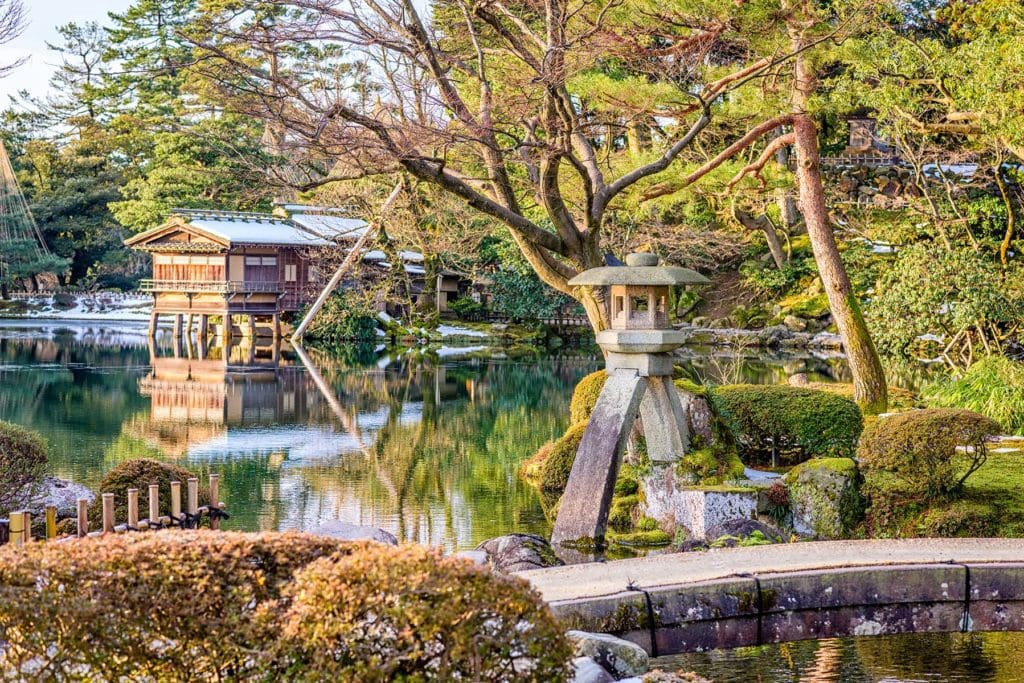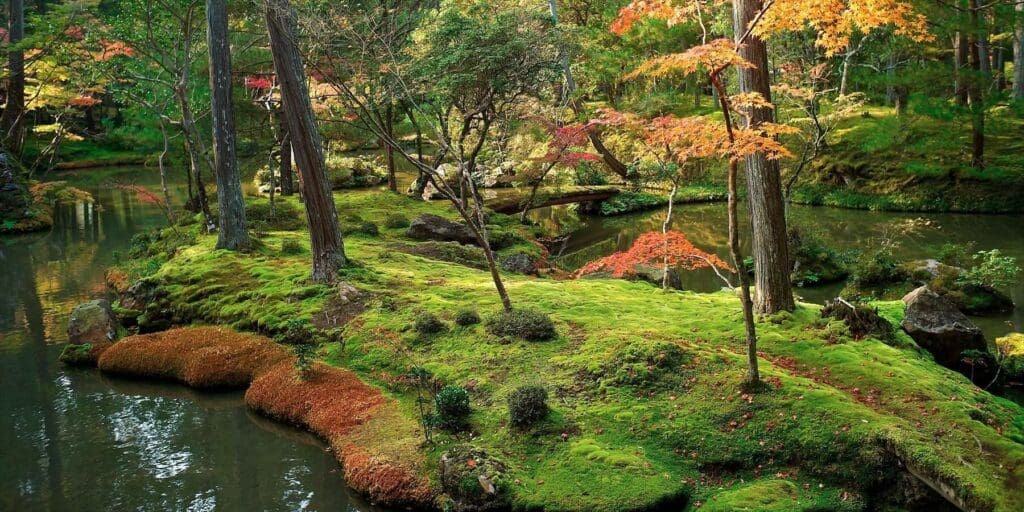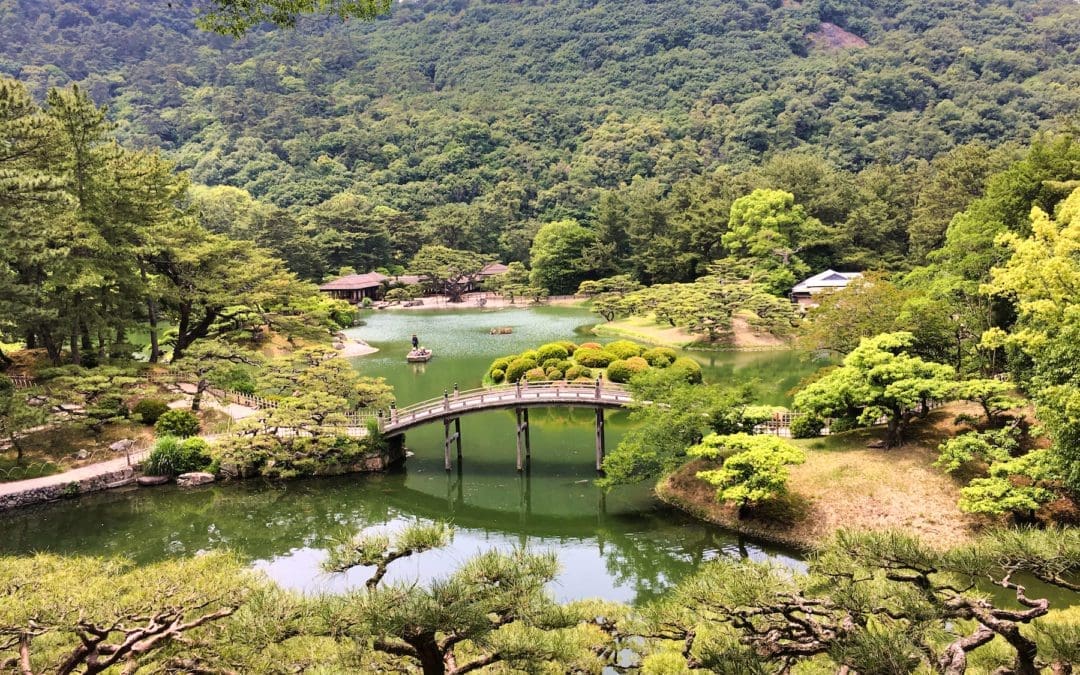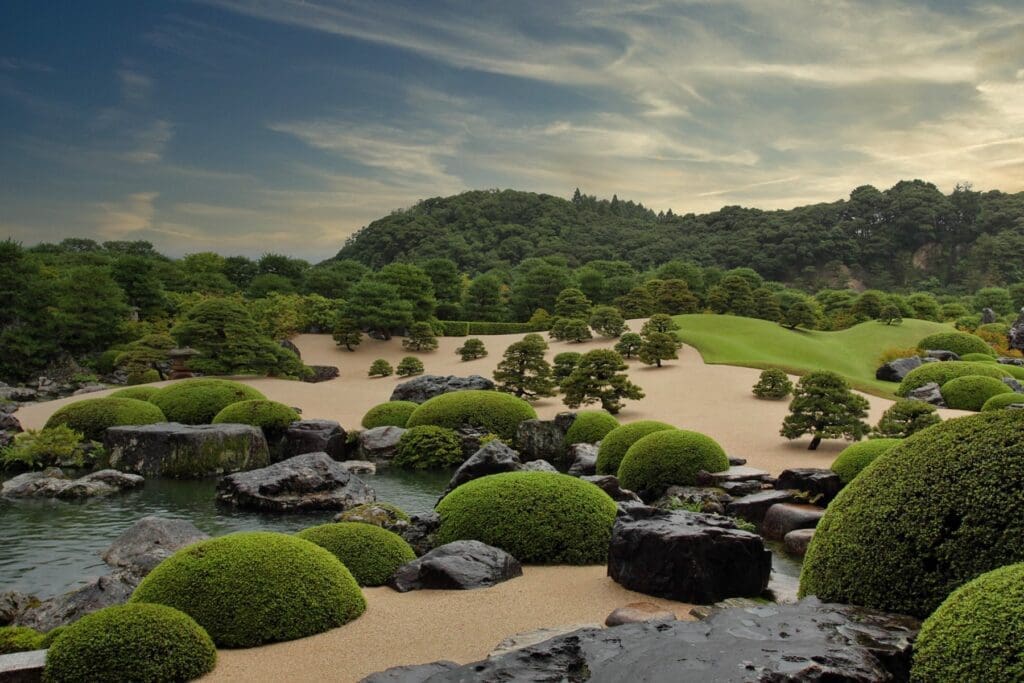Top 10 Gardens in Japan
1) Kenroku-en in Kanazawa

A favourite of most international tourists, Kenroku-en dates back to 1676. With approximately 8,750 trees and 183 species of plants in total, Kenrokuen is every garden enthusiast’s dream. It consists of ponds, streams, rocks, mounds, trees, grassy expanses, and footpaths. During the Edo era (1603-1867), garden design departed from the Zen minimalism of the preceding Muromachi era, as the ruling class rediscovered its likings for extravagance and recreation. The product was large strolling gardens with ponds, islands, tea houses and artificial hills that could be enjoyed from a variety of viewpoints along a circular trail.
Developed fastidiously over two full centuries, it has been maintained meticulously ever since. The spacious grounds formed the outer garden of the stunning Kanazawa castle, where the Maeda family ruled for over two centuries during the construction of the garden. Originally the preserve of the feudal ruling class and their guests, it was kept private until it opened to the public in 1871. Of the three famous gardens in Japan, Kenroku-en is said to best showcase winter beauty; but it also features a variety of flowering trees, which provide the garden with a different look for each season. Whilst there are times of peak bloom in spring and so on, visitors can appreciate its stunning views during any month of the year.
Different sections of the garden use gardening techniques from different periods and incorporate various features to create a unique “flow” throughout the garden. These features (ponds, hills, and streams) have special symbolic resonance based cultural aesthetics derived from classical literature and art. The Kotoji-toro stone lantern is one such example, designed to resemble the bridge on a koto, a stringed musical instrument that is the national instrument of Japan. Visitors enjoy roaming around the garden, walking along the circular path with large ponds, and watching the meandering streams, scenic hills, stunning villas, and tea houses surrounded by old trees. And given the absence of any tall buildings on the horizon, you can easily lose yourself in this fascinating old world of beauty and colour, away from any modern reality.
Renowned for its fusion of the conflicting elements of spaciousness and seclusion, the garden is laid out with the theme of unbroken space, allowing one to see a good portion of it from anywhere on the grounds. However, there are also many nooks where one can enjoy the feeling of solitude amidst the open space. A popular attraction is the Kaiseki pagoda on the island in the center of Hisago-ike pond. Kenroku-en means “garden which combines six characteristics” – the six aspects considered important in the notion of an ideal garden: spaciousness, serenity, venerability, scenic views, subtle design, and coolness.
Featured on
2) Kairaku-en Garden in Mito

Built relatively recently in 1841 by the local lord Tokugawa Nariaki Kairaku-en stands apart from anything else in Japan. Unlike the other two of the “Three Great Gardens of Japan”, Kairaku-en was not kept as the private reserve of the feudal ruling class and their associates for hundreds of years before opening up to the public. Rather Kairaku-en means “a garden of everybody’s pleasure” and was one of the first gardens to be built with the intention of making it public. This was significant as it served as a blueprint that helped to precipitate the opening up of other previously private gardens in Japan. This novel concept lead to the development of public parks in Japan.
Ranked among Japan’s three finest landscape gardens, Kairakuen is most famous for its over 3,000 plum trees. Of the “Three Famous Gardens in Japan”, Kairaku-en is said to best represent the spirit and colours of the spring season. There are over 100 different species of Ume (plum) trees in the 13 hectres of garden grounds, each with their own variation of white, pink and red colouration, spread throughout half the garden. Unsurprisingly, the peak season to visit this garden is during the Plum blossom period which tends to occur from late February to the end of March. Other seasonal plants such as rape blossoms and cosmos also feature amongst the cedar woods and bamboo grove.
Azaleas also feature in the garden and are usually in full bloom from late April to early May and can be best seen looking down from the third floor of Kobuntei, the primary residence in the park.Azaleas also feature in the garden. Views of Senba lake can be also be enjoyed from this vantage point. Feudal Lord Nariakai Tokugawa created the garden as a park for feudal lords and commoners. He designed Kairakuen for education, training, and relaxation.
3) Koraku-en Garden in Okayama

One of the “Three Famous Gardens of Japan”, Koraku-en is said to best represent the beauty of Autumn. Located on the north side of Okayama Castle, the Korakuen was completed in 1700 and incorporates the surrounding hills and castle into the design. Koraku-en means “gardens of pleasure after”, which is a reference to a saying attributed to Confucious explaining that a wise ruler must attend to his subjects’ needs first, and only then should he consider his own interests. The views of the garden from the castle are breathtaking and it is easy to transport yourself back in time to imagine what the feudal lords must have been feeling when looking out over their wonderful creation.
Also, constructed in the Edo period, the garden was designed for strolling around and permits visitors to enjoy discovering different looks and vistas from hidden vantage points that need to be experienced first-hand to be truly appreciated. The experience brings a sense of peace and tranquility to anyone who spends some time walking through this classic traditional Japanese garden. The garden is surrounded by a water filled moat, it incorporates a pond internally and features a man-made stream that flows for 650 metres through the garden. Yuishinzan Hill offers stunning views of plants like azaleas and rhododendrons and seasonal red and white flowers. Special scenic spots in Korakuen include Enyo-tei House, the most important structure in the garden. This was destroyed in a fire during the second world war but restored using original materials to the exact specifications as it stood for hundreds of years. Another famous feature is Kayo-no-ike Pond – famous for its white flowers of daimyo lotuses (known as ‘universe’). Yet another popular feature of the extensive garden is Chishio-no-mori Grove; with its maple trees that are especially beautiful in spring when they are in bud.
By early June, the Japanese Iris Garden. complete with its Yatsuhashi Bridge, becomes a stunning sight with it purple and white blooms. In autumn, during Koyou (changing of the leaves) period, the garden truly becomes breathtaking and offers unrivalled views of the Autumn leaf colours along its many paths and bridges.
4) Adachi Museum of Art Japanese Gardens
Adachi Zenko, a textile wholesaler from Shimane prefecture, opened the museum with its gardens in 1980. At this time he was already 71 years old. Adachi Zenko loved Japanese paintings and gardens since his youth. Today, Adachi Muesum won the price for the best Japanese Garden in Japan for Thirteen Consecutive Years! “The garden is also a picture.” – Welcome to the World of Great Artistic Gardens
The gardens vary in appearance every day. In fact, we might never see each beautiful moment again, and this is why the whole garden is always full of beauty. The founder, Adachi Zenko, with the belief of “the garden is also a picture”, devoted himself to gardening until he died at the age of 91. The gardens, including the Dry Landscape Garden, are about 165,000 square meters in total. They show various seasonal faces, and have good balance with the surrounding natural mountains. Thus, Adachi’s gardens are said to be a “living Japanese painting.” There are several gardens around the museum. The main garden is the Dry Landscape Garden, but we can also find the Moss Garden, the Tea Garden, the Pond Garden, which is the oldest garden on the grounds, and the White Gravel and Pine Garden, a tribute to the works of Yokoyama Taikan.
There are several gardens on the museum’s grounds, which represent different styles. Even before entering the Museum, the visitor is welcomed by the “Reception Garden” (kangei no niwa). This reception garden already introduces the beauty of Japanese gardens to the visitor. We find a stream made of sand with some rocks set into the scenery. The banks are covered with beautiful moss, and Acer will add a colourful touch in autumn. On the right side of the entrance, we see a more open space with gravel, but in a similar design style. This garden can be seen from the inside too, which gives a new viewing-angle to it.
The main garden is the Dry Landscape Garden, which is connected to the Moss garden. Both gardens are the first ones to be seen when entering the Museum. The next garden is the garden of the tea house Juryu-an. It was named by Sen Soshitsu, a tea master of the Urasenke School. The house and garden were built in imitation of Katsura rikyu’s Shokin-tei in Kobori Enshu’s style. The next garden is the Pond Garden. It is the oldest garden in the museum. It already existed before the museum opened and became the entrance in 1970. In 1984 it was remodelled to the existing state.
5) Hamarikyu Garden

Take a step into this beautiful Edo-period (1603–1867) garden and discover a world separate from the city. Originally built to serve as a feudal lord’s residence, the gardens are located on the edge of Tokyo Bay, separating sea from land and incorporating the changing tide into the garden’s design. The Hama-rikyu Gardens are built around a central pond. In the middle of the pond is a teahouse, where you can sit down to enjoy a cup of matcha tea throughout the year. The garden’s pond is connected to the sea, and water flows in and out with the tide, meaning the park is in a permanent state of flux.
Throughout the park there are a number of plum and cherry trees, which blossom throughout spring. You can see autumn foliage from the end of October, peaking in early to mid-November. Near the entrance of the park stands a 300 year old pine tree. The tree is really impressive in the area it covers, and its branches must be kept up with sticks. The 300-year-old pine tree is said to have been planted to celebrate the 6th Tokugawa shogun, Ienobu. Miraculously, the tree survived world war 2, when other parts of the park was heavily damaged. The Hamarikyu Gardens were opened to the public in April 1946, but served as a feudal and imperial retreat for several centuries before that. The gardens were completed under the guidance of the 11th Tokugawa shogun, Tokugawa Ienari. After the Meiji Restoration of 1868, they became a villa belonging to the imperial household, before being given to the city of Tokyo in 1945.
Historically used as a duck-hunting ground and a retreat for the nobles, many of its traditional vestiges can still be found. It is a remarkable place for nature photography, and remains beautiful, come any season, with the plum blossoms in full bloom during February and cherry blossoms in April. The traditionally styled garden stands in stark contrast to the skyscrapers of the adjacent Shiodome district.
6) Yuushi-en garden

Between Matsue and Yonago Airport sits Daikon Island, home to dreamlike YUUSHIEN Garden. Here you can wander stone paths, cross bridges arching above streams and ponds, and marvel at the painstakingly cultivated flora. Located on Daikonshima Island, Yuushi-en consists of a 40,000 square metres garden with the peony flower as it’s predominant symbol. With peonies, Japanese irises, autumn leaves, and so on, the circular paths in this Japanese garden are colored differently each season by the flowers and trees.
You’ll find over 250 varieties of peony in bloom, along with azaleas, hydrangeas, and other blossoms. All the waterfalls and streams will help keep you cool in the summer. Autumn brings brilliantly colored foliage for Insta-perfect photos. The colder months often bring snow, and the garden’s caretakers put up lights to turn the grounds into an illuminated winter wonderland. In spring, the ‘30,000 Peony Pond’ is filled with peonies, as seen in the photo. In addition, there is also the Japanese Peony House with blooming peonies year round,
Yuushien, a ‘miniature garden of Izumo’, featuring landscapes and mythology of Izumo area, is a traditional Japanese-styled walk-through garden around ponds. Visitors can enjoy prominent peony flowers which can be viewed all year round as well as the many colours of the various seasonal flowers. There is a restaurant and café both serving high quality food and beverages and the restaurant provides customers with a lovely garden view and services fine cuisine from local ingredients.
7) Ritsurin Koen

Ritsurin Koen is a landscape garden in Takamatsu City, built by the local feudal lords during the early Edo Period. Considered one of the best gardens in Japan, it is often suggested that Ritsurin Koen deserves a spot on the list of the “three most beautiful gardens of Japan” alongside Kanazawa’s Kenrokuen, Mito’s Kairakuen, and Okayama’s Korakuen. The spacious park features many ponds, hills, historic trees and beautiful pavilions, divided into a Japanese style garden in the south and western style garden in the north. The gardens are set in front of wooded Mt. Shiun which serves as a wonderful background and great example of borrowed scenery. Built in 1625 on the orders of the Ikoma clan, the park was originally just an ornamental lake, with Mount Shiun-zan as a backdrop.
It took nearly a century of development for the current park of 75 hectares to obtain its exceptional beauty. The garden, in the hands of the Matsudaira family for 228 years, gradually became a remarkable example of “a Japanese Garden”. The six ponds, wooded hills, pavilions and bridges combine with the surrounding mountains to make Ritsurin Koen an illusory natural environment of infinite dimensions.
The new Meiji government came to power in 1868 and requisitioned the garden. Despite an initial proposal to build a silk mill, Ritsurin was designated a prefectural garden and opened to the public on 16 March 1875. In 1953, the garden was designated a Special Place of Scenic Beauty. Inside the park are a number of facilities, including a folk museum, shops and a few resthouses where you can take a break and enjoy some refreshments amidst the beauty of the garden. Of particular note is the Kikugetsu-tei teahouse in the southwest part of the gardens, where, for a small fee, you can enter and enjoy some tea on its verandas overlooking the ponds.
8) Kumamoto Suizenji Garden

Suizenji Garden is a spacious, Japanese style landscape garden in Kumamoto, best enjoyed by strolling along a circular path. It was built by the Hosokawa family in the 17th century. Suizenji’s history heralds back to 1637 when it was chosen by the 3rd Hosokawa Lord as a site for a tea house and small temple due to the presence of many underground springs. The crystal clear water bubbles up feeding the large pond and flowing onwards to Ezu lake. The spring water originates in Aso, apparently taking 20 years to travel underground to the Suizenji area. The springs are at a constant temperature of 18C and the water is fabled to bring great longevity to whoever who drinks it.
Suizenji Jojuen is a stroll garden set around a pond fed by springs from Mount Aso. Two stone bridges that date from the Meiji era (1868–1912) are at the entrance. To the east, on the far side of the lake, is a strikingly symmetrical tsukiyama, or artificial mountain, evoking the shape of Mt. Fuji. The gardens which cover 6600 square meters were developed and extended by the 4th and 5th Lords of Kumamoto taking around 80 years to complete. According to different sources the garden was originally designed to portray 12 scenes from the Kumamoto region and it is also said to represent the 53 stations of the Tokaido Road (the original route to Tokyo). The garden reproduces the 53 post stations of the Tokaido, the important road, which connected Edo with Kyoto during the Edo Period, in miniature form, including a small Mt. Fuji.
9) Saiho-ji Temple (UNESCO) (Kyoto)

Located in western Kyoto, Saiho-ji Temple is also known as “Koke-dera Temple,” which means “Moss Temple,” and the temple’s luxuriant mossy growth is its claim to fame. Over 120 types of moss are present in the two-tiered garden, resembling a beautiful green carpet with many subtle shades. The lower tier centers on a pond that is shaped like the Japanese character for “heart.” Trees create pools of shade which play over the moss. In autumn, the maple leaves turn bright red making a vivid contrast. The upper tier is a rock garden with stone formations that resemble islands in a green sea.
Built on the site of an ancient temple, Saiho-ji Temple was restored and made into a Zen temple in 1339 by the monk Muso Soseki, who is also said to have designed the upper tier of the garden. Saihoji Temple is a temple of the Rinzai sect of Zen Buddhism. During the Nara Period, thirteen hundred years ago, at the request of Emperor Shōmu, the priest Gyōki founded forty-nine Hosso Sect temples, Saihoji temple being one of them. It is said that before the temple was founded, during the Asuka Period, it was originally one of Prince Shōtoku villas.
In the early Heian Period, Kōbō Daishi temporarily lived in the temple, but by the Kamakura Period, Hōnen had made its conversion to a Jōdo Sect temple. In 1339, amid the postwar devastation of the times, Musō Kokushi, one of the most highly respected Zen priests in Japan at the time, revived it as a Zen temple, at the invitation of Fujiwara Chikahide (the chief priest of Matsunō Shrine).
Since then, the temple has been visited by many who are interested in practicing Zazen, including Ashikaga Yoshimitsu and Yoshimasa. It is also said that Saihoji Temple was the prototype of temples representative of the Muromachi Period and the model for temples to follow, such as the famous Kinkakuji (Golden Pavilion) and Ginkakuji (Silver Pavilion). The 35,000-square-meter garden is currently listed among the Historic Sites and Places of Scenic Beauty of Japan and was registered in 1994 with UNESCO’s World Cultural Heritage as a Historic Monument of Ancient Kyoto. Today, due to the beautiful moss that covers the area, it is also popularly known as the Kokedera (Moss Temple).
Many Zen temples were founded around seven hundred years ago, during the Kamakura Period, an era famous for the prosperity of Zen Buddhism and its many works of art that have been preserved. However, having been founded in the Tempyō Period (A.D. 729–749), Saihoji temple’s history stretches back over twelve hundred years. It has maintained its prominence, even while housing different sects, and its longevity is rooted in the fascination of those who have visited throughout the many eras. In 1994, Saihō-ji was registered as a UNESCO World Heritage Site, as part of the “Historic Monuments of Ancient Kyoto”. To visit Saiho-ji, one must make a reservation at least 1-2 months in advance.
10) Ryoan-ji Temple (zen garden) in Kyoto, UNESCO Site

It is Japan’s most famous “hiraniwa” (flat garden void of hills or ponds) and reveals the stunning simplicity and harmony of the principles of Zen meditation. Ryoan-ji Temple is famous for its mysterious rock garden, the most celebrated in Japan, which defies attempts at explanation. Enclosed by an earthen wall, fifteen carefully placed rocks seem to drift in a sea of raked white gravel. A viewing platform right above the garden gives visitors an unimpeded view, although from whatever angle you view the garden, you can never see all fifteen stones.
After sitting and pondering the garden’s “sermon in stone,” you can stretch your legs by touring the extensive grounds of Ryoan-ji Temple, which includes larger gardens with trees and moss, and the Kyoyo-chi pond, which is particularly striking in autumn. Once refreshed, you can return to the rock garden for another look before leaving. The temple was built in 1450 by Daimyo Hosokawa Katsumoto (1561-1628), but no one knows for certain when the rock garden was made, who designed it, or what the designer’s intentions were.
The temple served as a mausoleum for several emperors. Their tombs are grouped together in what are today known as the “Seven Imperial Tombs” at Ryōan-ji. The burial places of these emperors—Uda, Kazan, Ichijō, Go-Suzaku, Go-Reizei, Go-Sanjō, and Horikawa—would have been comparatively humble in the period after their deaths. The temple’s name is synonymous with the temple’s famous Zen garden, the karesansui (dry landscape) rock garden, thought to have been built in the late 15th century.
The garden is a rectangle of 248 square meters (2,670 square feet), twenty-five meters by ten meters. Placed within it are fifteen stones of different sizes, carefully composed in five groups; one group of five stones, two groups of three, and two groups of two stones. The stones are surrounded by white gravel, which is carefully raked each day by the monks. The only vegetation in the garden is some moss around the stones. The garden is meant to be viewed from a seated position on the veranda of the hōjō, the residence of the abbot of the monastery. The stones are placed so that the entire composition cannot be seen at once from the veranda. They are also arranged so that when looking at the garden from any angle (other than from above) only fourteen of the boulders are visible at one time. It is traditionally said that only through attaining enlightenment would one be able to view the fifteenth boulder.


